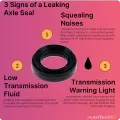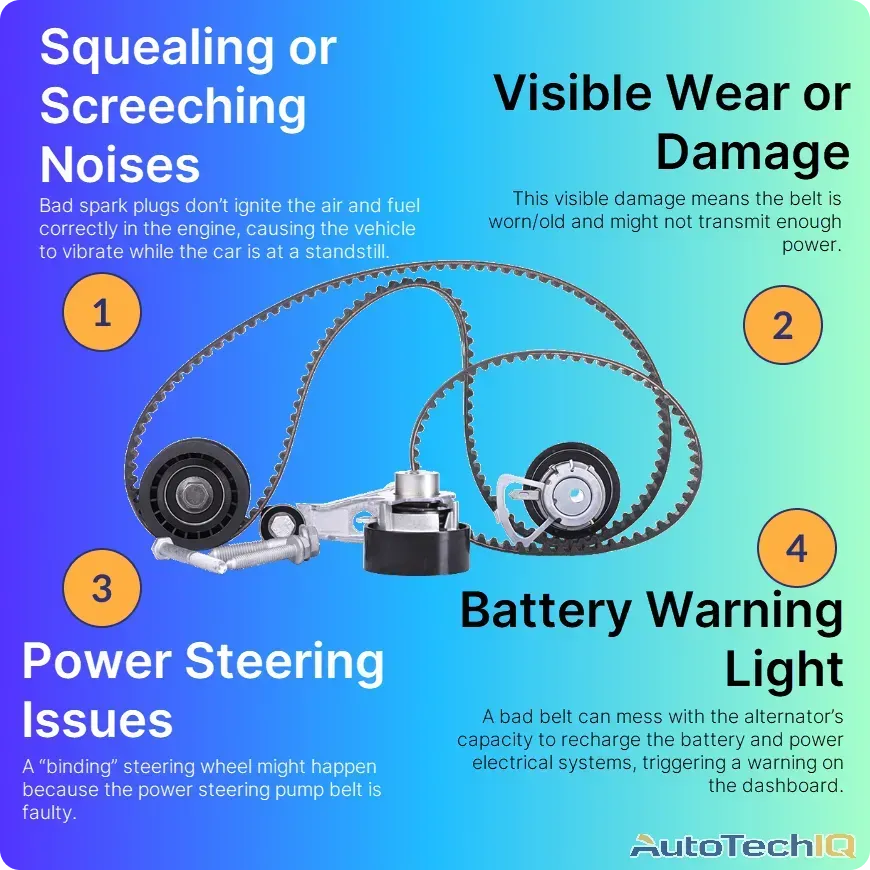
What is a drive belt?
A drive belt, also called a serpentine belt, is a long belt-like component that rotates along the engine's gears; the drive belt spins with the engine, generating power for different systems. This component's main role is to power accessories in your vehicle, like the alternator, power steering pump, air conditioning compressor, and sometimes the water pump. It transfers power from the engine’s crankshaft to these components. It's vital to inspect and replace this component to prevent accessory damage.
What are the most common questions and doubts about a drive belt?
Is a drive belt the same as a serpentine belt?
Yes, while all serpentine belts are drive belts, not all drive belts are serpentine belts. A drive belt is a generic term for any belt in the electrical niche that transfers power to other devices; this means it isn't automatically related to cars. However, a serpentine belt is a specific vehicle drive belt that powers various accessories like the alternator, A/C compressor, and power steering pump. Still, due to context, if the subject concerns vehicles, the drive belt means the serpentine belt.
What does the drive belt do?
The drive belt transfers power to other vehicle accessories. So, it runs along the engine's gears, generating power to the A/C, power steering, alternator, ABS, and air conditioning compressor, to name a few. So, the drive belt enables these performance-related systems to function, making it an essential component in vehicle operation and maintenance.
Is a drive belt the same as a timing belt?
No, a drive belt and a timing belt are different components within an engine. A drive belt, or serpentine belt, transfers power from the engine’s crankshaft to accessories like the alternator and air conditioning compressor. In contrast, a timing belt synchronizes the engine’s camshaft and crankshaft. This synchronization makes internal combustion-related engine components move in time. So, the timing belt is more related to the engine cylinders.
What are the 3 belts in a car?
The serpentine belt, the V-belt, and the timing belt. In detail, the Serpentine Belt powers other accessories like the alternator and power steering pump through a single, continuous belt. The V-Belt is a narrower belt that drives one accessory per belt. The Timing Belt keeps a synchronized movement between the crankshaft and camshaft, helping engine combustion. Different vehicle models may use different belt configurations based on design and engineering.
What happens when a drive belt goes bad?
When a drive belt goes bad, engine accessories like the alternator, power steering pump, and air conditioning compressor stop functioning properly or stop working altogether. This issue leads to battery drain, heavy or unresponsive steering, and loss of air conditioning. Additionally, a damaged belt might produce squealing noises. A bad drive belt means further complications or potential damage to other engine components.

What are the most common things a driver might notice about a drive belt needing service?
Squealing or Screeching Noises
A high-pitched squeal from under the hood usually indicates a loose or worn drive belt. The sound typically comes from the belt slipping on a pulley since it has weaker tension and grip. In this case, it'll need replacement.
Visible Wear or Damage
Regular inspection may reveal noticeable wear, cracks, fraying, or missing chunks on the belt. This visible damage means that the belt is degraded and won't transfer enough power. In this case, it'll need a replacement to avoid sudden failure.

Power Steering Issues
Tough steering, or a “heavy” steering wheel, often means the serpentine belt, which powers the power steering pump, is compromised. A malfunctioning or broken drive belt can impair the pump’s operation, affecting steering.
Battery Warning Light
The battery warning light on the dashboard indicates that the alternator isn't making enough electrical power; this is often related to a failing drive belt. A bad belt hampers the alternator’s capacity to recharge the battery and power electrical systems.
Overheating Engine
In some vehicles, the drive belt operates the water pump. A failing belt interrupts the coolant flow, causing the engine temperature to rise. An overheating engine can cause severe damage and unsafe vehicle operation.

Each of these symptoms can happen due to a bad drive belt. If you notice any of these from your car, address them promptly to avoid further damage to other engine components.
How do shops identify and plan a drive belt service?
A drive belt service can happen differently from vehicle to vehicle; it depends on the issue and root causes. However, top-tier educational auto shops do standard and guided diagnostics to review a vehicle's condition.
To illustrate exemplary customer service concerning drive belt issues, we'll describe a fictional occurrence.
In an auto shop, Mr. Gray complains that his car is making squealing sounds from the hood. He also mentions dealing with some issues where the A/C stops working, and the steering gets tougher.
Scott, the mechanic who takes Mr. Gray's concerns, starts a careful inspection.
Inspect: After opening the hood, Scott inspects the drive belt, identifying wear signs like glazing, fraying, and cracking. With his tablet, he takes photos of these damages, creating clear visual documentation to show and explain Mr. Gray later.
Test: Scott, equipped with professional tools, checks the belt's tension and alignment. While doing so, he explained to Mr. Gray how a properly aligned and tensioned belt should perform. He demonstrates, with a belt tension tester, how slack or too-tight belts can become an issue in the engine. The worn belt's loose grip on the pulleys becomes noticeable in close-up tablet images.
Evaluate: Scott shows Mr. Gray the photos he took of the drive belt, pointing to the damaged areas and worn signs. Then, Scott makes a side-by-side comparison with pictures of a new, healthy belt. He explains their difference using straightforward language and images/videos to bridge any technical knowledge gaps. Scott explains the consequences of driving with a worn-out drive belt, which can result in vehicle breakdown in extreme cases.
Diagnose: With a digital platform, Scott writes a diagnosis, illustrating the current state of Mr. Gray's belt versus optimal conditions. He shares videos that show the functioning of a healthy belt against one showing signs of wear. The comparative visual data appears in an easy-to-understand format, helping Mr. Gray see the necessity of the recommended service.
Confirm Repair is Completed: After Mr. Gray approves the service, Scott begins the replacement process, inviting him to witness the procedure. After replacement, Scott does the initial tests again, checking if the issue is gone. He shows new images of the new tensioned belt, ensuring Mr. Gray can notice the before and after states of his vehicle’s drive belt assembly.
Finally, Scott ensures that all images, video explanations, and post-service data are shared with Mr. Gray. Then, he schedules a follow-up, showing ongoing support and assurance of the service provided.
In this scenario, Scott blends technical service with customer education. This methodology fortifies a transparent and trustworthy relationship between the vehicle owner and the service provider. This kind of approach reinforces a sustainable client-service provider relationship.
Top 5 Causes of Failing Drive Belt and Their Symptoms
Improper Belt Tension
Symptoms: A high-pitched squeal during engine operation, especially on start-up, signals inadequate tension and the potential for slipping on pulleys.
Misaligned Pulleys
Symptoms: Uneven belt wear or shredding on the edges indicates misalignment, causing the belt to ride improperly on the pulleys.

Worn Belt Material
Symptoms: Visible cracks, frays, or glazing on the belt indicate material degradation, risking unreliable power transmission to engine accessories.
Contaminants and Debris
Symptoms: Squeaks or squeals while running and potential belt slipping due to oil, dirt, or debris reducing the belt’s grip on pulleys.
Faulty Belt Tensioner
Symptoms: Fluctuating tension visible by irregular belt movement and accompanying whirring noises point towards tensioner malfunction or wear.
These causes and symptoms are important to check during routine vehicle inspections, ensuring optimal functionality and longevity of the drive belt and related systems.
Top 5 Drive Belt Fixes
Adjusting Belt Tension
Properly recalibrate or replace the belt tensioner, ensuring the belt maintains an optimal, consistent grip on all pulleys.
Aligning Pulleys
Employ a laser alignment tool or straight edge to adjust pulleys, ensuring parallelism and coplanarity for smooth and straight belt tracking.
Replacing Worn Belt
Remove the aged, cracked, or frayed belt, installing a new one while adhering to the manufacturer’s guidelines for optimal performance.
Cleaning Belt and Pulleys
Utilize a belt dressing or specific cleaner to remove contaminants, enhancing grip and preventing premature wear and slippage.
Installing a New Tensioner
Replace the faulty tensioner with a new unit, ensuring it properly maintains belt tension and supports consistent accessory drive operation.
There's an auto shop near you delivering fair, transparent service like you've read here.
Feel free to visit our 'Shop Near You' page and search for our certified repair shops in your area. These businesses provide top-notch services while also offering expert inspections using advanced diagnostic tools. You'll witness the same level of care and attention to detail that we've highlighted in this article. These shops share our goal of ensuring that your vehicle receives the best possible maintenance. At this goal's core, your knowledge of what's happening to your car and how to maintain it is our #1 priority.
Summary
Understanding drive belt issues can be odd for vehicle owners. This guide explains the complexities surrounding drive belt wear, offering insights into symptoms, causes, and fixes. The article also explains technical processes through fair language, promoting an informed, hands-on approach towards vehicle maintenance. The focus of educated vehicle service is to produce knowledge on maintaining optimal belt health, ensuring smooth vehicular operation, and proactively averting potential breakdowns through preventative practices.
Other news
-
Car is Squealing When Driving
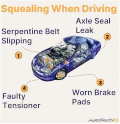
-
What is Preventative Maintenance and What Are The Benefits of it?

-
JobViewIQ - DVI Process Training - Part of the Auto Care Alliance Benefits

-
7 Signs of AC Pulley Issues
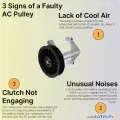
-
7 Signs of Clogged AC Components
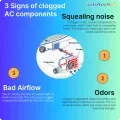
-
How Much Does a Transmission Fluid Change Cost?
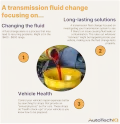
-
7 Signs of a Leaking Axle Seal
